On Tuesday night Greenwich First Selectman Fred Camillo, Board of Education Chair Karen Kowalski and Schools Superintendent Dr. Toni Jones proposed budgets for 2024-25 to the Board of Estimate and Taxation budget committee.
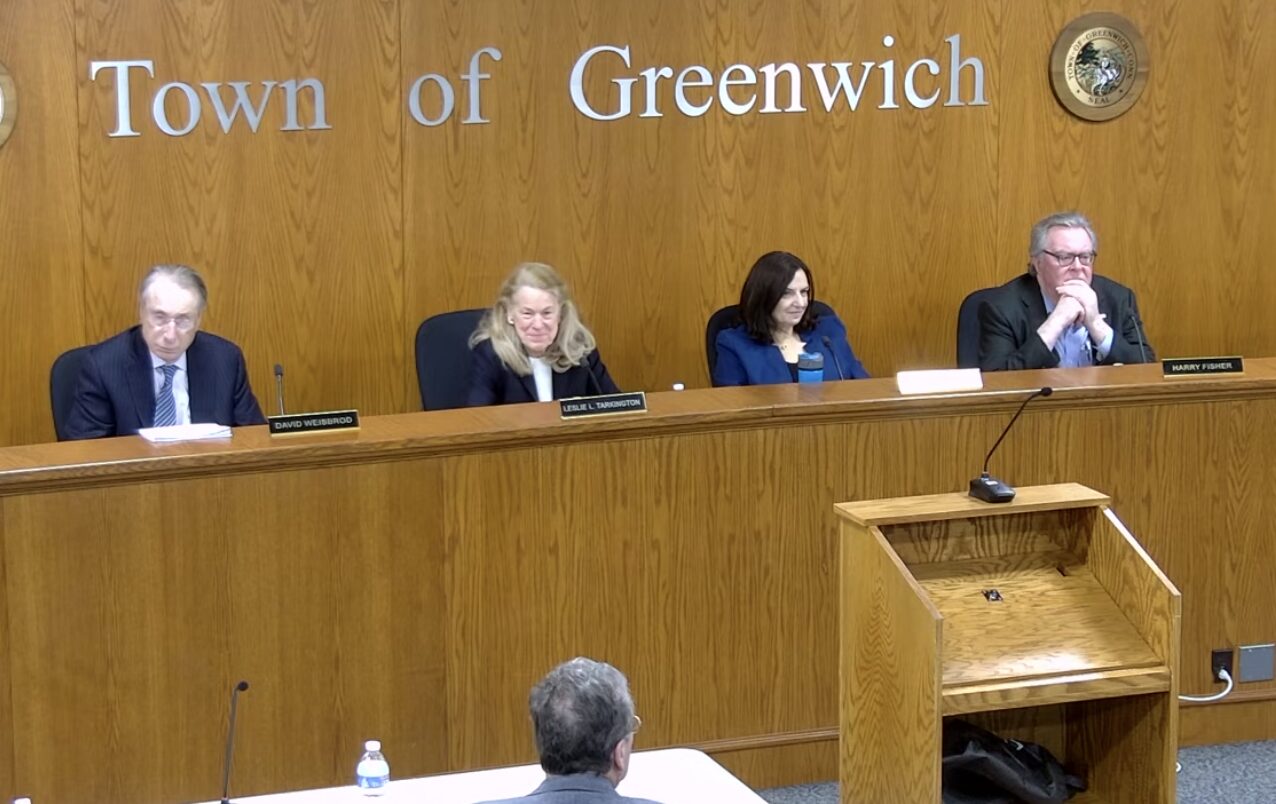
The budget committee which is chaired by Leslie Tarkington, (second from left) includes David Weisbrod, Leslie Moriarty and BET chair Harry Fisher.
First Selectman Fred Camillo presented his proposed operating and capital budgets, kicking off with a recap of the recent resident satisfaction survey where residents replied to an open ended question that quality of education and the state of the schools were their most important issues.
His proposed capital budget included annual investments in town infrastructure, including $3.75 million for annual paving, $2.0 million for highway maintenance, $750,000 for stormwater drainage, and $6 million for soil remediation at Greenwich High School.
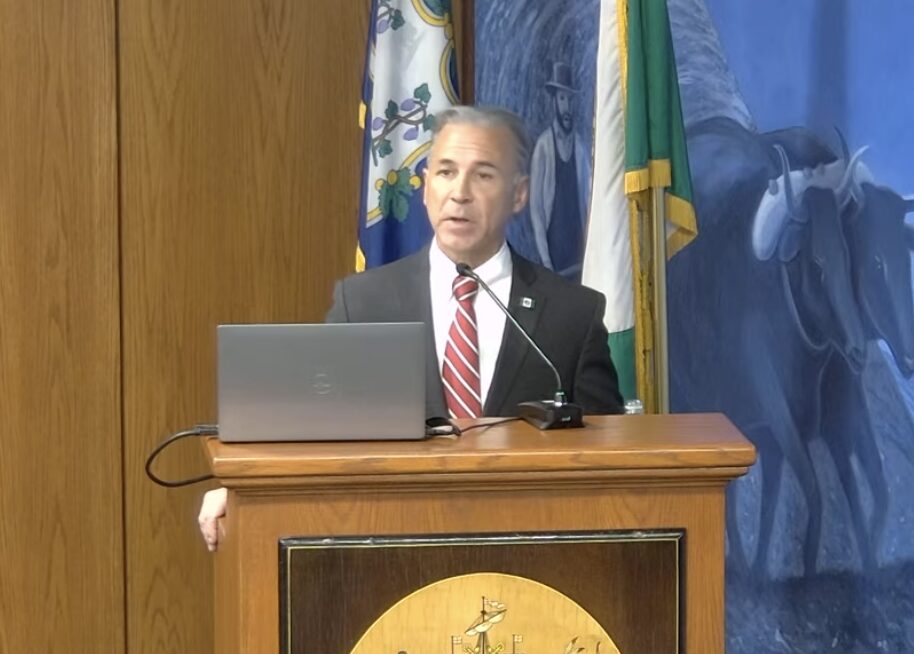
First Selectman Fred Camillo presented his proposed budget to the BET budget committee on Jan 23, 2024
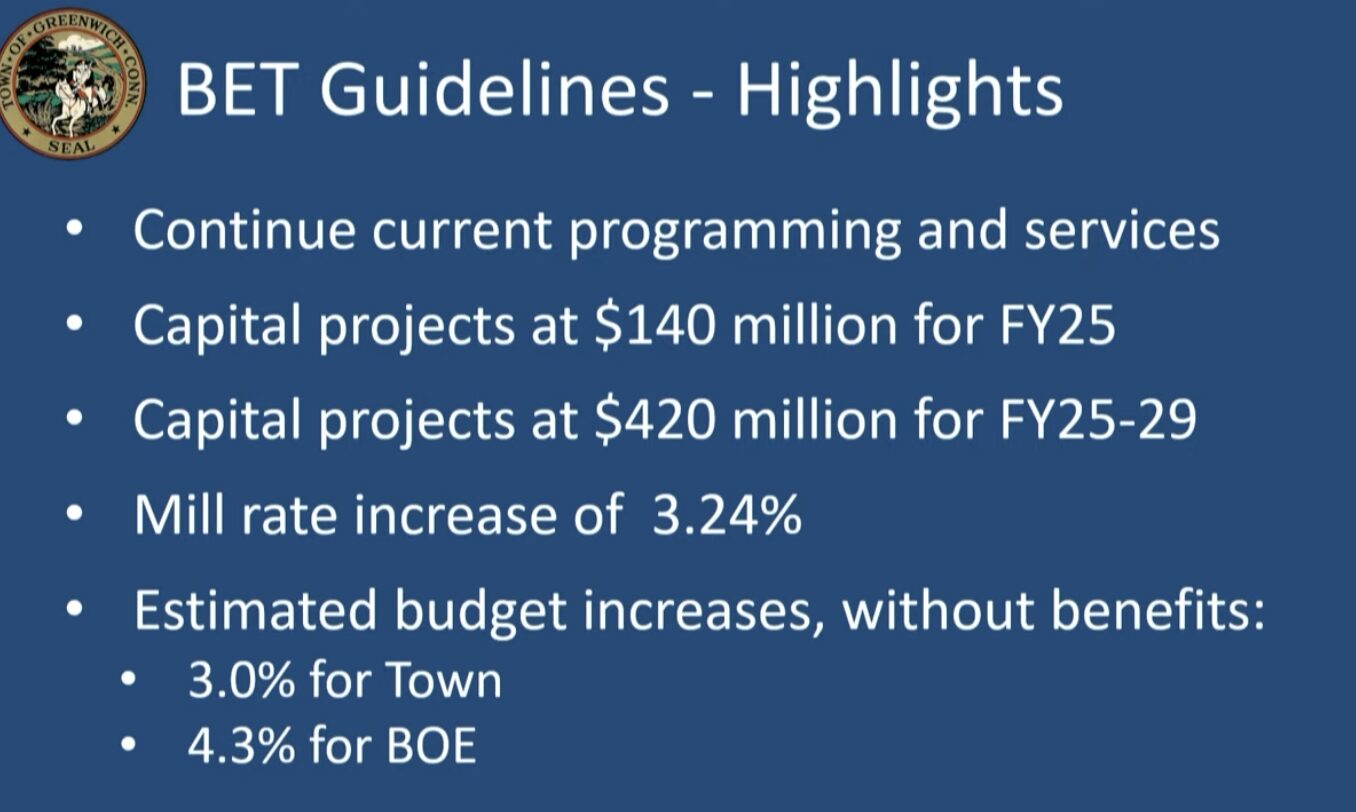
Mr. Camillo said the Capital Improvement Program (CIP) process had been flawed, and focus had moved away from a long term 15-year plan to a 5-year horizon.
“Things were bunching up,” he said.
He said the Shore Road sidewalk project had been successful and his FY’25 budget included $250,000 for feasibility and design for a sidewalk extension from Sound Beach Ave to Tod’s Point, and then $1.5 million for construction in FY’26.
He said the Congestion Mitigation and Air Quality “CMAQ” Route 1 adaptive signal timing would be paid for by grants, but required appropriation of funds. The price in FY’23 was $300,000 for design plans and $3.7 million in FY 25 for construction.
“This improves traffic signal timing and pedestrian safety by installing adaptive signal control technology,” he said, noting that new signals at Arch Street had been successfully moving traffic along.
He said the expanded CMAQ signal timing would run along Rte 1 from the Stamford border to the Port Chester border in Byram.
On the topic of pedestrian and traffic safety, Camillo said the Safe Streets for All program would reimburse 80% of $500,000 on a project in which residents would identify specific locations in Greenwich needing improvements.
Also proposed for the years FY ’25-30 is $100,000 annually for speed limit displays. Camillo said the “rectangular rapid flashing beacon” signs at various crosswalks improved pedestrian safety – some permanent, some mobile.
While funding is already secured for the Cohen Eastern Greenwich Civic Center, Camillo said was finally under construction.
“In summer 2024 the furnishing installations will be completed and the town will begin to hire and train staff in preparation for the opening of the building in fall 2024.
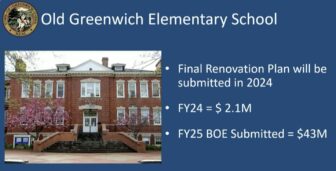 As for Old Greenwich School, Camillo said, “We couldn’t afford it last year with Central (Middle School project). Now is the time to get it done. We don’t want any more delays.”
As for Old Greenwich School, Camillo said, “We couldn’t afford it last year with Central (Middle School project). Now is the time to get it done. We don’t want any more delays.”
He commended the Old Greenwich School building committee for its work responding to the POCD and residents’ request to preserve the historic building.
He noted the BOE had requested $43 million for FY ’25 for Old Greenwich School, reflecting an increase of $4 million.
“It’s only going to keep going up,” he said.
He noted soil remediation at Western Middle School was underway, with oversight from the Connecticut DEEP and the US EPA.
Cleanup and prep started last month and restoration and replanting are targeted to take place in spring/summer 2024 with a $2 million contingency in FY 2025.
As for revenue to the town, Camillo said 92% of the increase reflected Fire Dept review fees ($150,000) and a proposed increase in municipal solid waste tipping fees increasing from $112 to $119/ton, for a total increase of $78,000. Also there was an increase of $241,000 for rental of town facilities, and an increase of $298,720 from the town owned nursing home the Nathaniel Witherell.
Head Count
Camillo said staffing the Cohen Eastern Greenwich Civic Center, on its way to completion, would be restored. When the new building reopens staff will run a new, bigger and better building.
He proposed two additional positions, starting with a position to oversee sustainability, energy management and coastal resiliency. He said this position would pay for itself because the person would “claw back dollars from the state and federal government.”
Second, he proposed to add a code enforcement officer to follow up on complaints about noise, quality of life and zoning.
Mill Rate
As for the town’s mill rate, which determines property taxes, is currently 11.762. If the budget passes as proposed, it would increase to 11.881, for a $488 increase in property tax on a house assessed at $1 million.
Camillo said property taxes impact everyone, but even with the increase, Greenwich’s rate would still be the second lowest in Connecticut.
“We’re spending a lot of money, but we’re also doing it in an efficient way, taking into consideration all those people here who are on fixed incomes and love living here, and we want to make sure they are able to live here going forward,” Camillo said.
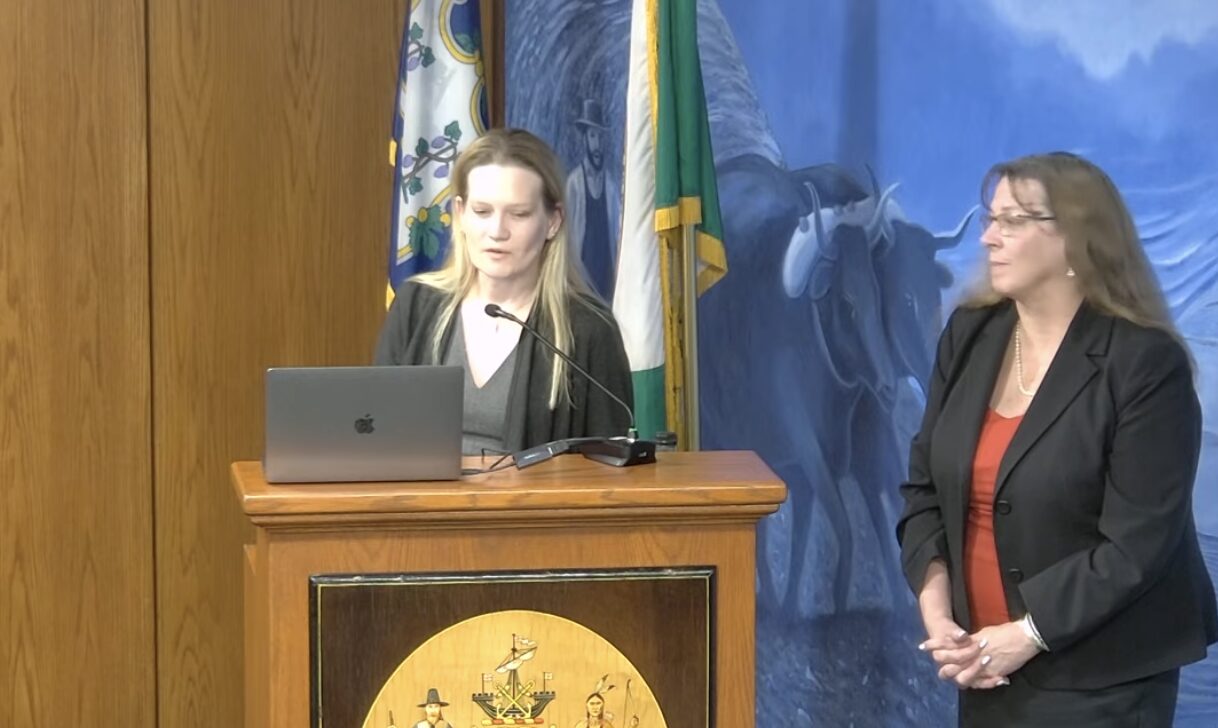
BOE chair Karen Kowalski and Greenwich Schools Superintendent Dr. Toni Jones
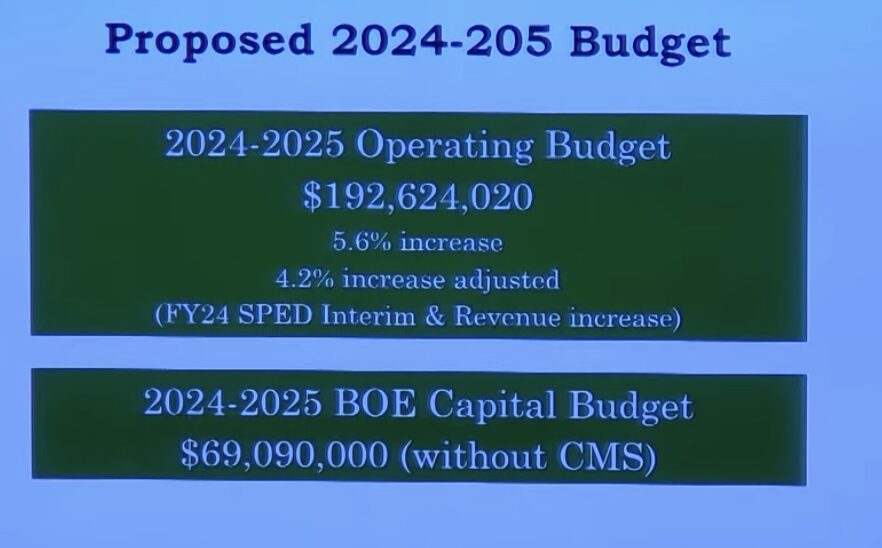
Pre School and Special Education
BOE chair Karen Kowalski said the proposed operating budget was $192,624,020, reflecting an increase of 5.6%, though BET guidance was for an increase of just 4.3%.
Kowalski put the proposed 5.6% operating budget increase in context, saying it was driven by legal mandates from the state for Pre-K and special education.
“I would bucket our students in three different categories that drive the amount of our budget,” Kowalski said.
She listed special education students, regular education students and pre-K students, which she noted were “unknown figures.”
She said special education legislation now required services be provided longer, through the age of 23.
She noted the district recently went to the BET for an interim appropriation for special education reflecting what she described as an additional unfunded mandate, and added that the funding had been approved by the RTM.
Dr. Jones said between 2019 and 2023 the district’s special education population had increased 189 students.
She said Greenwich had gone from a 10% special education population to 14% and that the district anticipated that increase to continue. She added that the state was at 17% and other districts were at 18% or 19%.
“For every 15-24 students we add, we need a special education teacher – that’s a case load. And some of those children also need speech services, psychological services and the more students we test, the more psychologists we have to have to do that testing to meet those federal deadlines and timelines,” Jones said.
Kowalski said staffing adjustments – retirements and attrition – were also considered, and fixed costs included transportation and salaries for teachers and administrators based on contracts.
Also she said state of Connecticut moved back the date children move into kindergarten, giving parents the decision to keep their children in Pre-K another year. (The new state cutoff for Kindergarten entry next fall moves the date a child must turn 5 back from Jan 1 back to Sept 1.)
She noted Pre-K presented unknown figures. “Because we often don’t know what kids are coming into our district, or even when.”
This in turn, will impact the number of teachers and sections the district offers. Pre-K is offered to students at the age of 3 on a rolling basis.

Fewer K-5 classrooms over time

Preschool growth over time…
Jones agreed that enrollment fluctuated, and the district was closely watching kindergarten numbers.
Kindergarten enrollment this year was 101 students above projections, which was significant considering it meant more classrooms had to be added when school started.
“It’s largely due to families moving into Greenwich for kindergarten,” Jones said. “But we’re also looking at the legislative change for kindergarten next year, so we’re a little bit unclear about what kindergarten is going to look like next year.
She said although the birth rate was lower in Greenwich, in-migration among people moving to Greenwich and choosing Greenwich Public Schools was driving kindergarten enrollment.
“It’s driving the kindergarten number higher than projected. It’s all the housing sales. I will be very much driven by the housing market,” Jones said.
Jones noted that while enrollment overall was leveling out over time – with 11,000 students in the 1960s and then a dip below 6,000 in the late 1980s – preschool was contributing to growth today.
“Where we have seen growth more than double is pre-school,” she said.
The pre-school program includes special education and general education students.
“You don’t know how many students will quality for the pre-school program, which is required by federal law,” she said. “Because we have doubled, we now have 16 classrooms of pre-school. We could fill a whole elementary school with just preschool (classrooms). We were not that way 10 years ago.”
She added that the number of English Language Learner students was also growing after having dipped in 2020. She said that increase required more staff and services.
Jones said during Covid the federal government had provided lunch for free to any student attending any school in the US, so Greenwich families did not submit paperwork for the program.
Today the district is urging families to turn in their forms for students on free and reduced lunch since grants are directly tied to the number of students on free and reduced lunch
As for the decline in K-5 classroom sections since 2016 and 2017, Jones said it had been helpful turn positions into special education, ELL or preschool positions.
Greenwich Schools Chief Operating Officer Blaize Levitan noted that that for the past several years the BOE operating budget had been kept below the rate of inflation, but today the special education and outplacement had impacted the budget.
Overall, he said the pressure of salary and contractual obligations, and the cost of substitutes, impacted the remainder of the budget.
He said base pay for substitute teachers was $110 per day, but long term subs were paid more.
“During Covid we were running about 300 day subs,” Levitan said. “We’re running a slightly higher average now. What that implies, post-Covid, is we’re not seeing a decrease in the use of day subs. It’s a significant budget pressure.”
Levitan noted the district’s operating budget featured transportation costs, including private school transportation that the district is required to pay for.
School Capital Budget
Levitan said the district’s proposed capital budget to the First Selectman was $118.5 million.
He said after removing the $49.5 million inflation adjusted number for CMS, funded by an interim appropriation, “We’re at $69+ million and 62% of that is the Old Greenwich School project.”
He said the total cost for CMS was $112 million.
“We still need to work with the delegation to make sure the project is added to the state’s grant list,” Levitan added.
As for Old Greenwich School the inflation adjusted number for the school project was $43 million, and the best estimate of reimbursement rate from the state was 15.6%.
“That’s important for debt service modeling,” he said.
The Julian Curtiss School renovation request was for $3,200,00 million and the GHS cell service improvement project was a request of $631,000, being broken into two years to target the most critical areas of the school first.
There was also a request for $150,000 for ed specs for a renovation at Riverside School.
Lastly, there was a request for $3,800,000 for district wide master plan for ADA compliance.
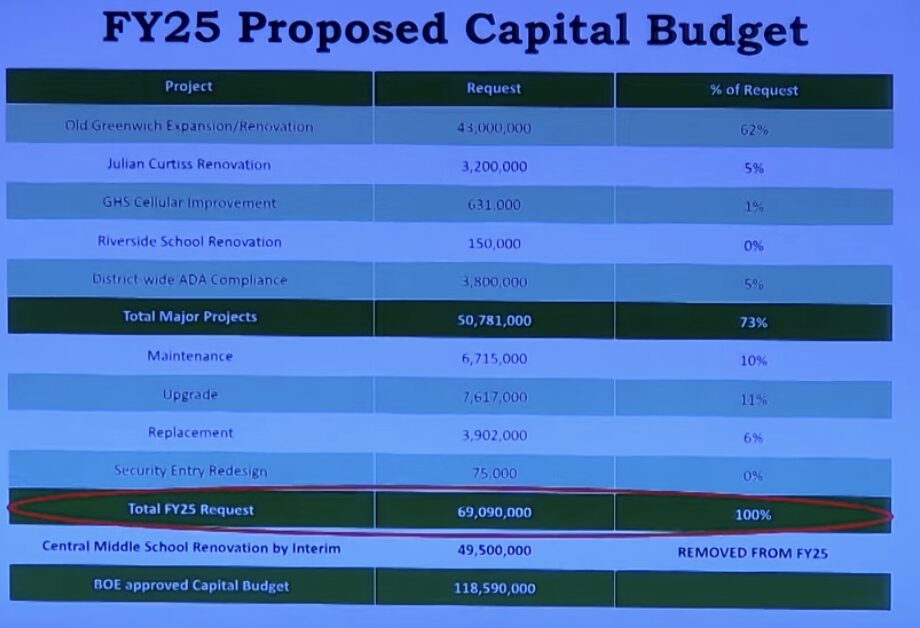
During public comment, there was an outpouring of support from staff and families to fully fund the school budget.
James Walsh of Cos Cob warned that, “If we continue to cut, nickle and dime our school buildings or educational offerings, we’ll start down the path where our facilities and educational experiences will be so vastly different from local independent schools and other public schools in southwestern CT, our parents will look elsewhere than our phenomenal GPS.”
Old Greenwich School
Dr. Jen Bencivengo, principal at Old Greenwich School, said enrollment was consistently on the rise there.
She said it was her 7th year testifying to request prioritization her school’s building project and thanked Mr. Camillo for including the project in this year’s capital budget.
“By prioritizing OGS you are ensuring a remedy for safety, accessibility and sewage remediation,” she said. “Our renovation will ensure that students, faculty and staff have a single, safe secure entryway, adequate HVAC in every classroom, a fully accessible building inclusive of not a ground level entry and elevator, but classrooms of appropriate door widths, plumbing with wheelchair accessibility and countless other remediations necessary to ensure no student ever has to spend months alone in a classroom with a sub because they have a broken leg and cannot get to their third floor class.”
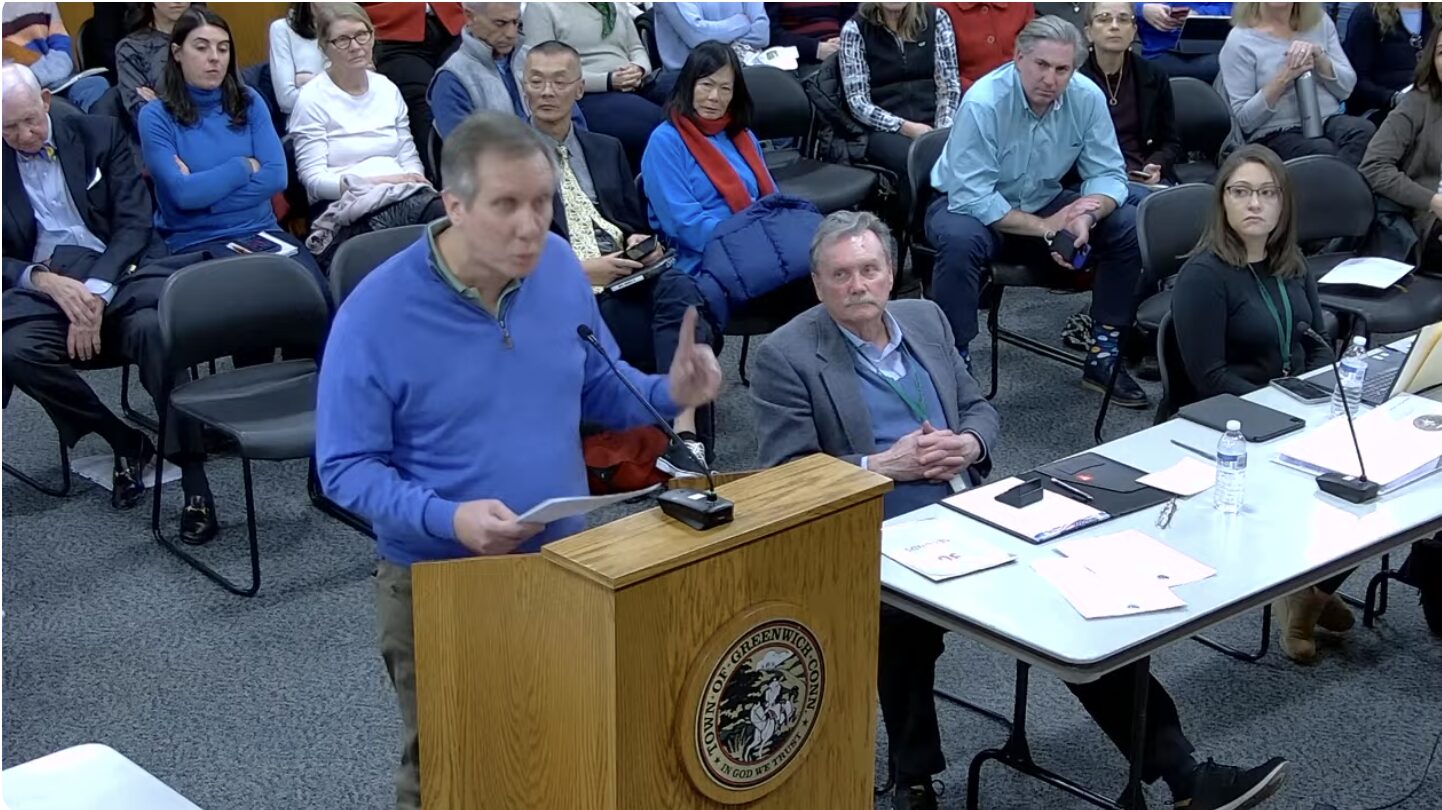
Former BOE member and chair Peter Sherr said he was shocked at the proposed schools budget. Jan 23, 2024
Peter Sherr
Former BOE member Peter Sherr described the BOE budget as out of control.
He said 10 years earlier the district had 300 more students, average class size has remained steady, K-5 ALP programs were consistent and mean SAT scores were the same.
“The educational program was delivered with 33 less teachers than Superintendent Jones proposed in this budget,” Sherr said. “How is it possible that the Superintendent could deliver the entire educational program with 33 less certified teachers and 300 more kids?”
“The only thing different is the central office and the leadership team. I hope you will live what you’re said when you ran for office,” he said to the BET members. “Fix schools with fiscal discipline and low taxes.”
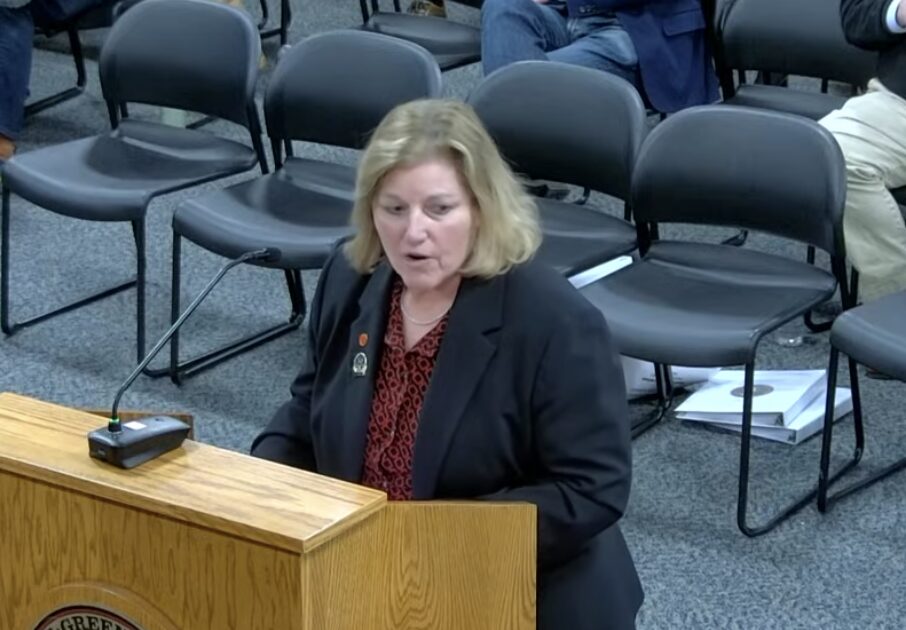 GEA President, Lil Perrone
GEA President, Lil Perrone
GEA president Lil Perrone shared a different point of view.
“I am tired of people making statements about 10 years ago we had more students and this smaller number of teachers,” Perrone said.
“The graduation requirements have changed – it went from 23 to 25 credits. There are new state mandates. And I am both shocked and appalled that people forget that we had Covid here for three years. Covid affected our staff, students and the community.”
Perrone said families lost loved ones during Covid, and students returned to school having lost critical thinking and problem solving skills.
“The whole world knows about Covid, but I guess there are some people here in Greenwich who must have forgotten about it,” she added.
“The budget needs to be passed,” Perrone said. “The teachers are upset and feel disrespected. We were called heroes. You told us you loved us, and how do you show us your love and appreciation? You keep cutting the budget.”

Zoning Enforcement Officer
Lucy von Brachel said the proposed additional zoning enforcement officer was urgently needed, especially in dense neighborhoods where health, safety and quality of life were issues.
She also urged the BET to fund GHS cellular service, which she described as a safety issue.
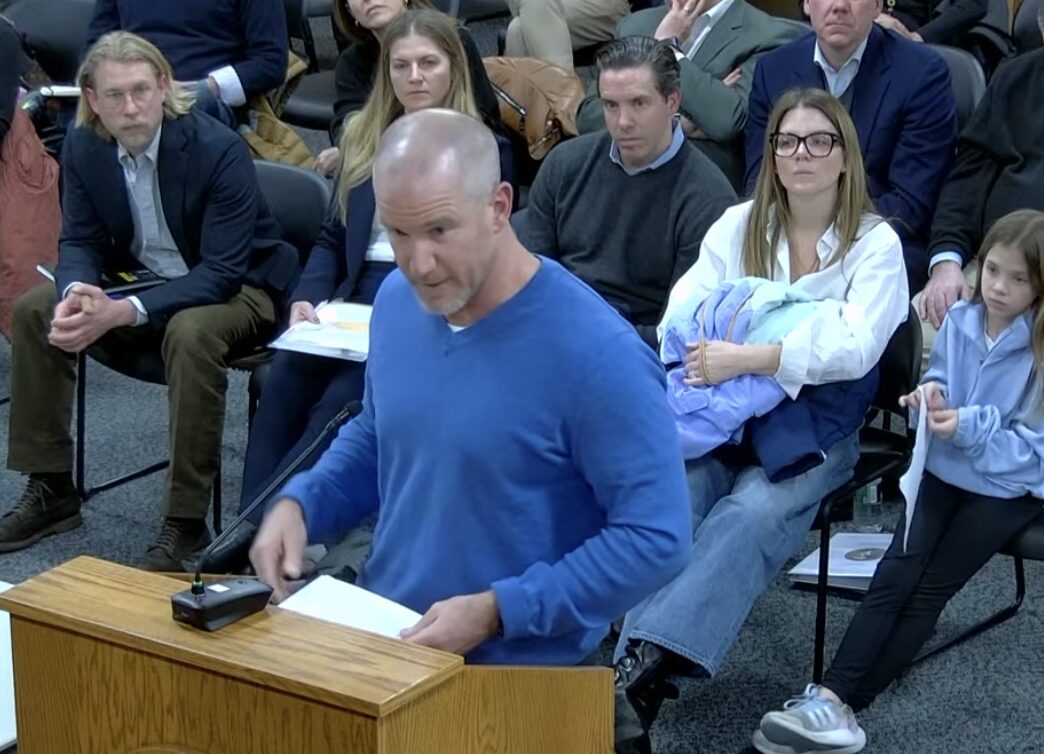
Kevin Molloy described being hit and badly injured by a car in 2014 when he was running along Shore Rd near Tod’s Point.
Extended Sidewalks on Shore Road to Tod’s Point
Old Greenwich residents also spoke in favor of moving forward as quickly as possible with the Old Greenwich School renovation and expansion, but also urging sidewalks be extended along Shore Road from Sound Beach Ave to to Tod’s Point.
The roadway is narrow, it curves, and features tall hedges making it potentially deadly.
Several residents testified, including Kevin Molloy who shared a personal story. Malloy said he was a marathon runner and that on July 13, 2014 he was hit by a car while on a run.
He noted that where Shore Road takes a sharp turn and is bounded by a tall hedge, runners typically cross over to run with traffic for better visibility.
He read from a police report that chronicled the morning he was hit by a car, noting he had spun in the air, landed on his head, left a large pool of blood, lost consciousness and suffered a severe concussion.
“This is an incredibly dangerous stretch of road and we need to do something about it,” he said.
Pickleball
The pickleball contingent again turned out in force, urging the town accommodate the huge appetite for courts by adding $100,000 for the courts at EGCC.
Jodi Stuart warned that neighboring towns had made room in their budgets to respond to the demand for new courts, but that Greenwich had fallen behind.
She said Stamford had 12 town courts, 4 hybrid courts, 41 courts with a fee, and 14 more on the way.
“When Greenwich residents go to neighboring towns to play pickleball, Greenwich loses revenue in clinics, leagues, lessons, gas and restaurant meals,” Stuart noted, adding that she planned to play at Pickleball American in Stamford with her group of 10 women later in the week when they’d rather stay in Greenwich.
She said last year the BET eliminated $100,000 from a $375,000 allocation to build four pickleball courts behind the new Eastern Greenwich Civic Center, and that until the full amount was appropriated Parks & Rec could not take the project out to bid and the project was on hold.
Vivian Wu from Cos Cob said pickleball was fun, healthy and connected members of the community, including people of all ages.
“There are many things that divide us in our country and our town, but pickleball brings people together. We just have fun,” Ms Wu said.
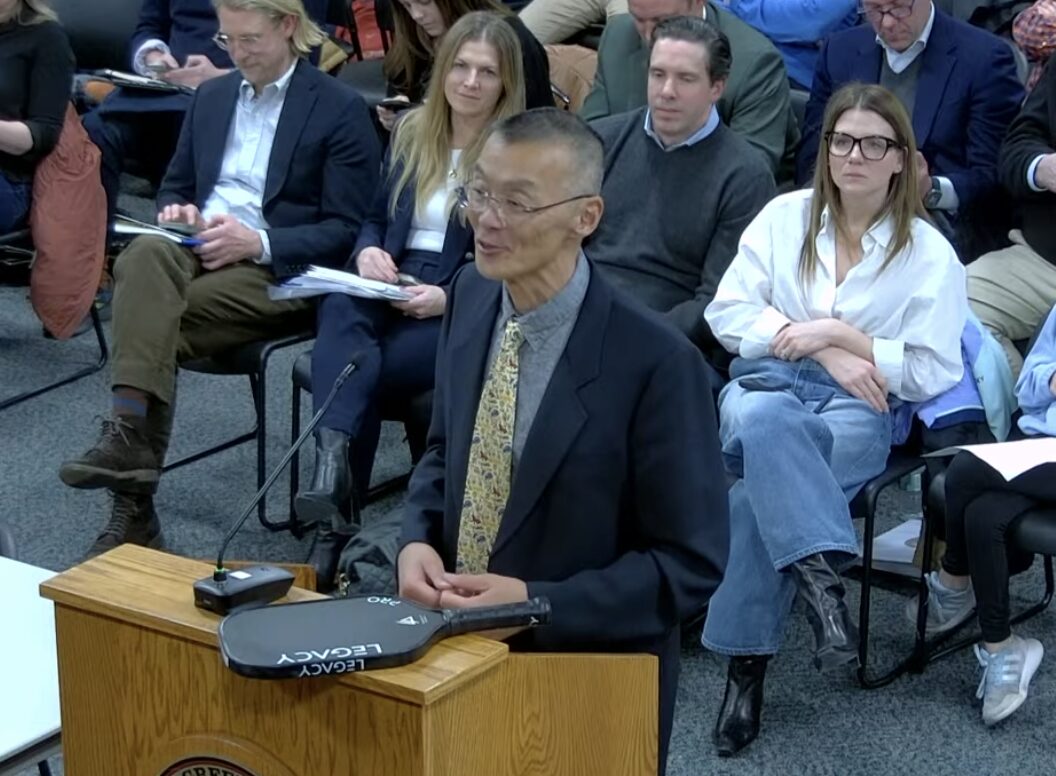
Pickleball enthusiast testified at the Jan 23, 2024 BET budget committee hearing
After about 2-1/2 hours, the meeting concluded when members of the public had three minutes to testify.
Ms Tarkington noted the meeting was the first in series of seven FY 2024-25 department meeting days, that would be followed by consolidation day and budget decision day on Feb 27, for a total of nine meetings.
From there, a BET budget hearing will take place on March 27 and finally BET decision day on March 29. Then, in May, the budget goes to the RTM.